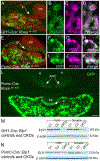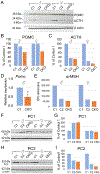Elongator regulates the melanocortin satiety pathway
- PMID: 35537288
- PMCID: PMC9156574
- DOI: 10.1016/j.bbrc.2022.04.128
Elongator regulates the melanocortin satiety pathway
Abstract
This study investigates the function of Elp1 and Elongator in the pituitary gland. Two conditional knockout models were generated where Elp1 was selectively deleted in either somatotropes of the anterior pituitary or Pomc-expressing cells of the anterior and intermediate pituitary. Although loss of Elp1 in somatotropes did not significantly impact murine growth or development, its loss in Pomc-expressing cells resulted in dramatically reduced levels of α-MSH, hyperphagia and obesity. This report provides the first evidence that Elongator plays an essential role in regulating the melanocortin satiety pathway.
Keywords: Elongator; Melanocortin; Pituitary; α-MSH.
Copyright © 2022 Elsevier Inc. All rights reserved.
Conflict of interest statement
Declaration of competing interest The authors of this manuscript have no affiliations with or involvement in anyorganization or entity with any financial or non-financial interest in the subject matter of this manuscript.
Figures




References
-
- Bjork GR, Genetic dissection of synthesis and function of modified nucleosides in bacterial transfer RNA, Prog. Nucleic Acid Res. Mol. Biol 50 (1995) 263–338. - PubMed
Publication types
MeSH terms
Substances
Grants and funding
LinkOut - more resources
Full Text Sources
Molecular Biology Databases
Miscellaneous

